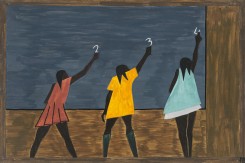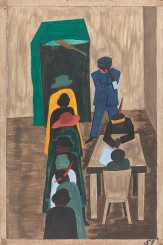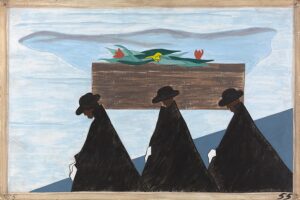For this project, I chose a cultural artifact to support Afrocentricity by Asante, Freedom songs (M&M,372) with the use of the song Poor Righteous Teachers ft. Junior Reid – Dreadful Day
https://www.youtube.com/watch?v=6uO44wZVCv0
& The 60-panel series I chose which is known as “The Migration Series” by Jacob Lawrence I chose can also be a sacred space because it is an art exhibit but also fits perfectly for a cultural artifact because it is used to depict the great migration. For this, I will be just presenting the website where the panels are on display with its captions made by Lawrence and explain the importance and message behind it. I will be connecting both these to Afrocentricity because that is what is being channeled with the production of both the music and art piece.
The link to the Website: https://lawrencemigration.phillipscollection.org/the-migration-series
— Essay
Afrocentrism through Art and Sound
The reading Afrocentricity by Asante has a concept which stood out tremendously in Black studies because it gives a new way to look at the information. The Afrocentric theory is proposing to look at blacks as subjects of their stories rather than objects. As said in the line, “Afrocentricity becomes a revolutionary idea because its studies ideas, concepts, events, personalities, and political and economic processes from a standpoint of black people as subjects and not as objects, basing all knowledge on the authentic interrogation of location (Asante, section 3).” Asante claims that a shift into African history is better rather than the European perspective and white history. It will have the impact of empowering the black perspective. As said by Asante in the lines “What is any greater than seeing the world through our eyes? What resonates more, with people than understanding that we are central to our history, not someone else’s? (Asante, paragraph 7) “and the lines, “Afrocentricity answers this question by asserting the central role of the African subject within the context of African history, thereby removing Europe from the center of the African reality (Asante, section 3)” This also revalues everything today rooting from black culture from ideals to art to culture into trends. This is why in connection to this theory I included a song written in the Afrocentric perspective about the struggles of being black in the American justice world. This song connects to Afrocentricity because he is taking all his horrific circumstances and how it is damaging to him and his community. Freedom songs is an example of Afrocentricity because it is embracing the African American struggle in order to empower themselves to fight for their freedoms. The Migration Series by Jacob Lawrence uses paintings to tell the story of The Great Migration. Lawrence also uses his artistic style and variety of colors to tell the story through an Afrocentric view.
This change in thinking is seen way before publishing by Asante, it can be seen during the civil rights movement with the usage of freedom songs. They used their story and struggle in order to encourage the community. These songs would show both their sorrow and strength. This can be seen in the lines “We shall overcome, we shall overcome, we shall overcome someday. Oh, deep in my heart, I do believe, we shall overcome someday. We are not afraid, we are not afraid, we are not afraid today. Oh, deep in my heart, I do believe, we shall overcome someday (M&M, 373)”. It can be inferred from these lines that this was a song made to motivate the black community in a time of oppression. With the use of “we” in the lines “we shall overcome someday; we are not afraid” shows the sense of unity that is present because the term “we” also recenters the perspective. The use of “we” in the lyrics also restates Asante’s theory of Afrocentricity; the “we” is putting the black perspective center rather than from the European oppressive view. During the civil movement when blacks were losing faith in justice, these songs reminded them of all they endured, and all they are capable of. Which is empowering both Africans past and their future. Since it is in their perspective nothing can be taken away from their story.
The cultural artifact which relates to the theory of Afrocentricity is the song Teachers Dreadful Day by Poor Righteous. (https://www.youtube.com/watch?v=6uO44wZVCv0) the song is about the corrupt American System and how it continues to bring many blacks into the system and is modern slavery. In the song, the artist is telling his story with the American system and how it has continually disenfranchised black people. These black teens that are talked about in the song are growing up around gangs and fall into the wrong crowd. Instead of prison rehabilitate them it tears them apart even further due to the worsening conditions than the outside. Slavery was outlawed but except in prison, where they work for barely anything. In prison, they are treated less than human and are in shackles some for crimes they did not commit. This song is significant to Afrocentric theory because the artist is taking his story back by telling it. Rather than just letting the system control him he is making himself the center of this story by saying it happened and what this event affected. The lines, “True; that day they took me away they had me bound in shackles, locked down twelve brothers connected by the ankles, by chains we dangled imprisoned for the star-spangled, Banner for glamour mad motherfucker’s slammer” is exposing the American justice system because America claims to be about freedom as seen with the reference of “imprisoned for the star-spangled” but tend to lock up and brutalize as many black men as possible. The writer also refers to his “twelve brothers in shackles” to show the rise of gang activity during the 20th century because of all this brutalization going on. The author is using an Afrocentric approach for this song by centering his story around his experience with the American justice/prison system by asserting his role in the system. He is asserting his idea of how flawed it is and how it has damaged him and many other black men.
( I showed the entire series from the website for the presentation
Where I will be showing the 60 panels, about the artist, its significance)
The Migration series from Jacob Lawrence made about 70 years ago with 60-panel paintings is made to depict The Great Migration. The son of Migrants, who moved to Harlem at the age of 13; and had piqued a huge interest in art from the Harlem renaissance. Lawrence then was given a grant by the Rosenwald Foundation to create the 60- panel Migration of the Negro now called The Migration Series. The journey of African Americans going from the South to the North. This Art series embodies the Afrocentric method because Lawrence is telling his story through the statement of these pieces as he stitches it into one and adds the caption for each piece. Even though he, himself did not go through it, his mother who is of African descent did. He utilizes the 60 panels as a big storybook each panel connected and sewn into one another. Each panel has Afrocentric features with the usage of colors and style seen in the clothing and background. Each panel guides you through the journey of The Great Migration and what it meant for African Americans.


These are a part of the last few panels which is depicting images during the end of the Migration where they had arrived in the North. They sought out more rights and job opportunities which is what they found at the end which is why their arms are up. The first one is showing the educational opportunity in the north for blacks as being more prevalent than in the South. Then the second showing that the North gave them the right to vote. These paintings help to connect the audience to the actual past event and see it from a clearer perspective. The purpose of this series was to show the universal theme of struggle but through African History to be reminded of the shared struggle. Therefore, this gives the black community a sense of unity and power.

This one in the series is depicting tuberculosis and the rise of quick death rates due to overcrowding. This shows that many people had to bury their loved ones due to the harsh conditions the North had and lack of concern by capitalists. They say a picture is worth 1,000 words but a brief description of the migration it is furthering the thinking and connections. These paintings are telling a story without the use of too many words, it is showing expression in the pictures. Expressions of pain, resilience, sickness, and strength can be seen through the colors and style of painting. The lines, “The poetry of Lawrence’s epic statement emerges from its staccato-like rhythms and repetitive symbols of movement: the train, the station, ladders, stairs, windows, and the surge of people on the move carrying bags and luggage.” from his art website shows the patterns of symbolism. Connecting to the lines “There were conflict and struggle. But out of the struggle came a kind of power and even beauty. ‘And the migrants kept coming’ is a refrain of triumph over adversity. If it rings true for you today, then it must still strike a chord in our American experience.” This line shows that the message behind this panel was to show even after African Americans went through such tough circumstances, they used that to power, to channel faith, in order to rise to triumph.
Citations
- Marable, M., & Mullings, L. (2009). Let nobody turn us around: Voices of resistance, reform, and renewal: An African American anthology. Lanham: Rowman & Littlefield.
- Molefi Kete Asante, The Afrocentric Idea. Philadelphia: Temple University Press, 1998.
Ama Mazama, ed., The Afrocentric Paradigm. Trenton: Africa World Press, 2003
Posted by Molefi Kete Asante
- Asante, Molefi Kete. “Afrocentricity.” Molefi Kete Asante Is among the Most Published Contemporay Scholars, Having Written over 70 Books and 400 Articles., 13 Apr. 2009, www.asante.net/articles/1/afrocentricity/.
- Lawrence, Jacob. “The Migration Series.” The Migration Series | Jacob Lawrence: The Migration Series, Jacob Lawrence © The Jacob and Gwendolyn Lawrence Foundation, Seattle / Artists Rights Society (ARS), New York, lawrencemigration.phillipscollection.org/the-migration-series.
- teachers, poor righteous. “Poor Righteous Teachers Ft. Junior Reid – Dreadful Day.” YouTube, YouTube, 26 Jan. 2008, www.youtube.com/watch?v=6uO44wZVCv0.


